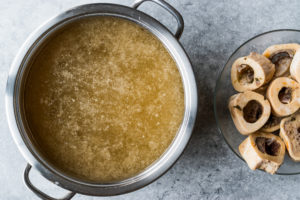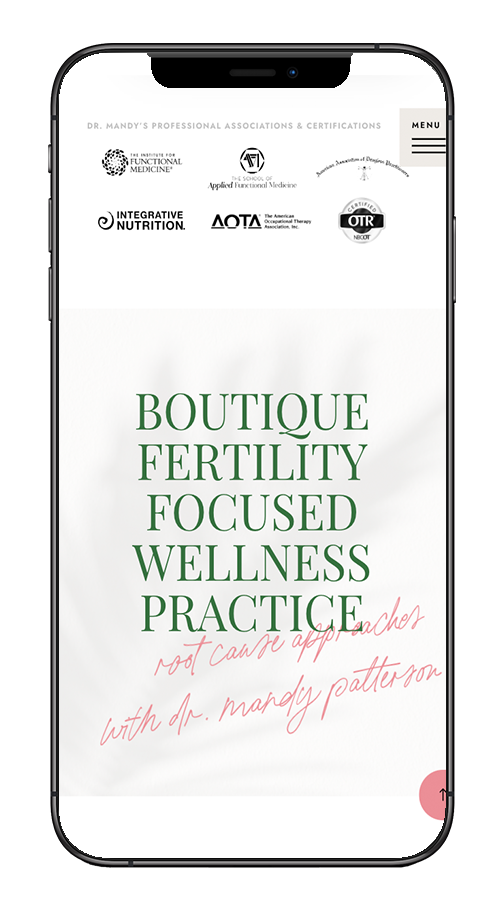If you’re a health conscious individual you’ve probably heard of bone broth benefits. It’s recently become all the rage (along with sourdough #ThingsThePandemicMadeUsDo). But, you may not know the multitude of bone broth health benefits. This health drink is liquid gold for your tastebuds and your health!
What is Bone Broth?
Remember back in the day when you got a cold and mom would whip out the Campbell’s chicken noodle soup? There’s a reason moms and doctors alike recommend hot soup when you’re feeling bad. In fact, research has found that the amino acids in chicken stock reduced inflammation in the respiratory system and improved digestion.
But, it actually goes back even farther than your childhood. Bone broth was a staple of many traditional diets from cultures around the world. So what is bone broth? It is essentially all the parts of an animal you can’t eat directly: bones, marrow, skin, feet, tendons, and ligaments.
Throw it all into a pot with water and let it simmer over a period of hours or even days. The bones and ligaments will eventually release healing compounds into the water creating a broth – which your body can then easily digest.
Nutrients in Bone Broth

Bone broth is rich in minerals and amino acids that are necessary for cellular energy and powering multiple other processes in the body.
Bone broth is very nutritious. Advocates of the Weston A. Price and Paleo diets use bone broth for it’s wide array of nutrients. Bone broth is also a staple of the GAPS protocol because of its ability to heal and seal the gut lining. In fact, it’s part of a larger idea called eating nose to tail.
Eating nose to tail is about consuming all parts of an animal so you source a wide range of nutrients your body needs. This is congruent with functional medicine as a core component of functional medicine is using whole foods to nourish and heal your body.
I’ve got your attention, but you want to know what the actual bone broth health benefits are and what nutrients you can find in this healthy liquid?
I aim to please, so here is a list of all the nutrients found in bone broth and what they do for your body:
Collagen – it makes up about 30 percent of the protein in your body and is the main component of connective tissues like: cartilage, ligaments, tendons, bone, and skin. Collagen also is an important part of tissue development and regulation.
Gelatin – this the product of simmered collagen. It’s chemical composition is similar to collagen, and it is what gives your broth it’s jell-o-like consistency. Gelatin also yields several important amino acids.
Glycosaminoglycans – these are complex carbohydrates. They can attach to proteins and form proteoglycans which are key parts of connective tissues and the lubricant that surrounds joints.
Glycine – this is an amino acid that makes up more than a third of collagen. Glycine acts as a neurotransmitter and is very important in mediating inhibitory neurotransmission in the brainstem and spinal cord.
Proline – another amino acid that makes up collagen. It is essential to the stability of collagen and it’s structure. Dietary proline is necessary to maintain an optimal level of it in the body.
Glutamine – yet another amino acid in bone broth, it is also the most abundant amino acid in the blood. It can directly cross the blood-brain barrier. Intestinal cells and activated immune cells consume glutamine for cellular energy.
Minerals – bones are full of minerals including: calcium, magnesium, copper, iron, manganese, phosphorus, potassium, sodium, and zinc.
Bone Broth Health Benefits
Okay, I know what you’re saying. “Great, Mandy, now I know a bunch of science that doesn’t actually tell me the bone broth health benefits that I actually receive.”
Don’t worry I’m about to tell you all the ahh-mazing health benefits that adding bone broth to your diet will entail.
Inflammation
Bone broth will benefit your immune system by reducing inflammation and preventing chronic inflammation that leads to a number of serious diseases. For example, the amino acids in bone broth have strong anti-inflammatory effects. Glycine also helps reduce inflammatory signaling molecules and oxidative stress that may reduce damage to lungs and other tissues.
Digestive System
Your overall health depends largely on the health of your digestive system. Bone broth contains gelatin which absorbs water and helps maintain the layer of mucus which keeps gut microbes away from your intestinal barrier, thus healing a leaky gut. Gelatine and glycine have been shown to reduce inflammation caused by leaky gut while glutamine has been shown to help maintain the integrity of the intestinal barrier.
Drinking bone broth is also healthy for your gut because it aids in digestion itself. Glycine stimulates the production of stomach acid and helps your body digest fats in the small intestines.
Bones and Joints
I mentioned above that collagen is the main protein found in bones, ligaments, and tendons. It may be intuitive that consuming collagen will also strengthen your bones and joints. But if you want to know the science behind it, bone broth contains glucosamine and chondroitin which are natural compounds found in cartilage. Studies show that these two compounds can decrease joint pain and lessen the symptoms of osteoarthritis.
Sleep and The Brain
Of the various bone broth health benefits we’ve got to include improved sleep and brain function to the list. Multiple studies show that glycine helps promote sleep. Additionally, chondroitin is very important in regeneration and plasticity in the central nervous system. That means it will help learning and memory, aka brain function.
Skin
That’s right, bone broth is even beneficial for your skin. Collagen consumption has been shown to improve skin elasticity and skin moisture content. Additionally, glycosaminoglycans are sown to promote skin cell proliferation and increase the presence of retinoic acid, which helps improve skin’s hydration. If you want healthy skin, drink bone broth.
How to Add Bone Broth to Your Diet
To summarize, bone broth health benefits are almost never ending. This ancient and healthy liquid has been shown to have a myriad of good side effects when consumed regularly. But, how do you add bone broth to your diet?
The first step is to know where to source it. You can find it at many grocery stores nowadays or make your own homemade bone broth. There are many recipes online, and I even like to share a recipe here and there in my weekly email newsletter.
Once you’ve obtained bone broth, you can use it in soups, sauces, and gravies. You can even drink it outright from a glass! Part of the challenge of adding bone broth to your diet is not knowing where to start.
Here is my favorite recipe that can be made in your crockpot.
Ingredients:
4-5 lbs bones from grass fed, preferably organically raised cows
Large pinch of unrefined salt
1-2 Tbsps apple cider vinegar
Filtered water
Add ins: carrots, celery, onion, peppercorns, parsley, or other fresh or dried herbs, such as ginger, turmeric
Directions:
Place bones in slow cooker. Fill with water until just covering the bones, and put in a few tablespoons of apple cider vinegar. Toss in your veggies, herbs, salt, and peppercorns. Cook overnight or at least 12 hours on high or 24 hours on low. Strain the liquid from the bones and vegetables into Mason jars. Allow to cool. Keep bones in crockpot but discard veggies. Refill with water to just covering bones and repeat directions. You can reuse these bones for up to 3 or 4 times. You can consume the broth immediately, place in refrigerator, or put into ice cube trays for the freezer.
As a Certified Holistic Health Coach, it is part of my mission to support you as you make changes to your life – like adding bone broth to your diet. I will help you adopt new behaviors that work for YOU and help you reach your health goals. Let’s talk about how I can help you, start by filling out the connect form here!



















